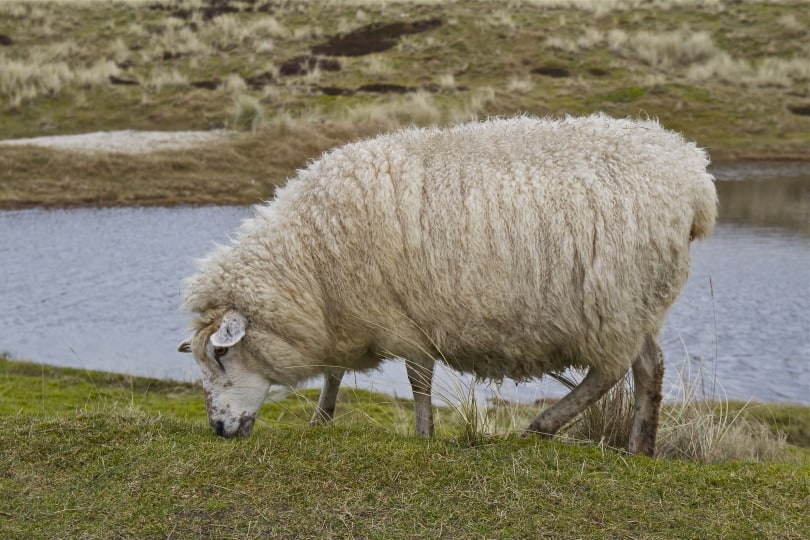To answer the first question concisely, yes, sheep can swim. Most animals can swim in the loosest sense of the word. Unlike humans who need to be taught to swim, the basics of swimming come to most animals instinctually.
Sheep do not fear water. They will enjoy sitting around the edge of a drinking pool and won’t be fazed if they get splashed. However, you usually won’t find sheep swimming for pleasure.
Without any instruction, sheep will quickly pick up how to float and “doggy paddle” to get across bodies of water. In the wild or extreme weather situations, sheep may need to swim small distances to secure food, shelter, or escape predators.
In February 2020, a man recording the flooding in New Zealand happened upon a group of sheep trapped on the opposite bank. After a bit of coaxing, the man was able to get the sheep to swim across the bank to his side. Further proving that, if necessary, sheep can swim.

How Do Sheep Swim?
A sheep’s swimming gait is similar to a horse’s trot but in water. Like dogs, they can keep their heads above the water and move their limbs in a paddling trot to keep moving forward. However, being able to swim doesn’t mean they like it or that it’s safe.

Why Swimming Is Unsafe for Sheep
Swimming presents genuine dangers to sheep that could easily be fatal. It’s highly recommended that you don’t have your sheep swim unless necessary; the cute videos aren’t worth the potential deaths.
Their Wool Is Heavy, Especially When Wet
Sheep wool becomes extremely heavy when saturated with water. The weight of their wool makes it difficult for the sheep to maneuver in the water and increases the exertion required to keep their body moving. It’s the same reason we usually take off our clothes before swimming for pleasure; the extra weight makes us less hydrodynamic.
Wool is a wondrous fiber. It acts like a thermos for the body, able to keep you warm or cool depending on what your body needs. It also wicks away moisture well. Wool can soak up to 30–35% of its weight in moisture before it even feels damp.

The average sheep in America has about 8.3 pounds of wool on their body, but sheep can carry around up to 30 pounds of wool. For just the average American sheep, their weight will increase by 2.49 pounds before their wool even begins to feel damp. A saturated sheep fleece can weigh more than 20 pounds easily.
Sheep are not particularly strong swimmers, to begin with, and their fleeces are like strapping weights to their bodies when swimming. For this reason, sheep should never be made to swim unless absolutely necessary. The added weight of their wool could prove fatal to them when trying to get across the water.
Even Weak Currents Can Carry Them Away
Because of the weight of their fleeces, sheep can very easily be carried away by even a weak current. Again, sheep aren’t particularly strong swimmers. They are not made or intended to be swimming and do not have the skills to navigate moving waters. Attempting to navigate running water will add to the already exhausting task of swimming with their fleece.
Even giving your sheep access to moving water like a river can be fatal to them. Should they slip and fall into the water, they could very quickly be carried away or drowned. Any access to running water should be limited if allowed at all, and sheep should never be left alone with running water.


Final Thoughts
Most animals can swim in the most rudimentary ways. Even if they’ve been domesticated, they’ll retain the wild instinct to float and swim if necessary. That doesn’t mean we should encourage or allow it. Terrestrial animals are terrestrial for a reason.
Featured Image Credit: Piqsels
